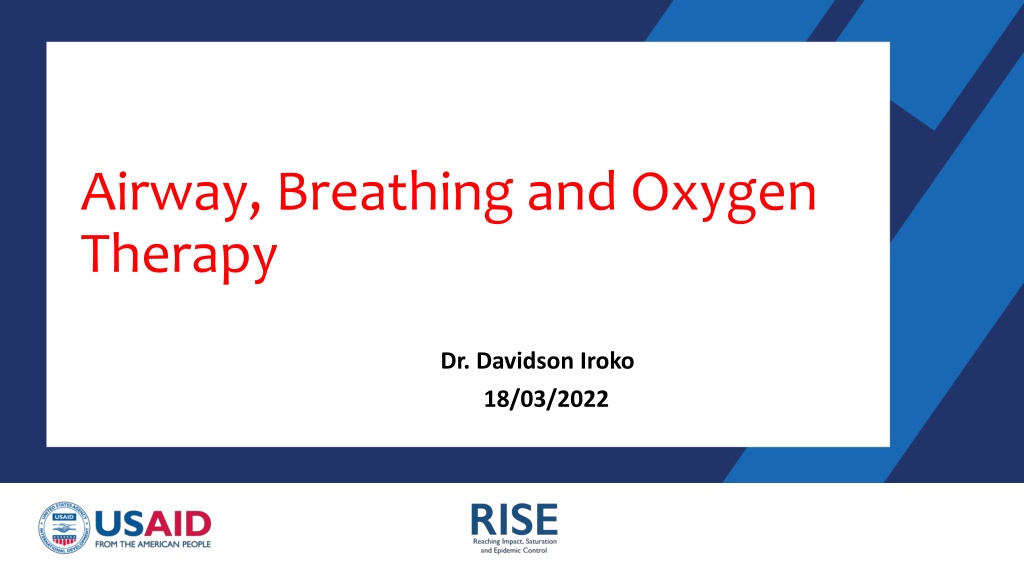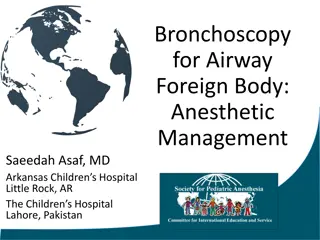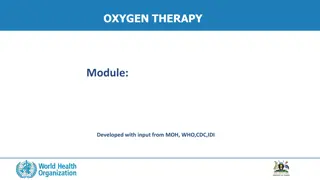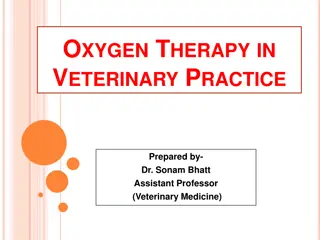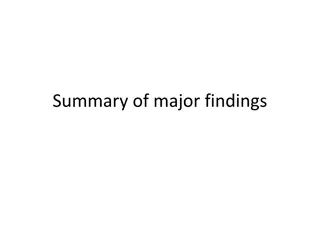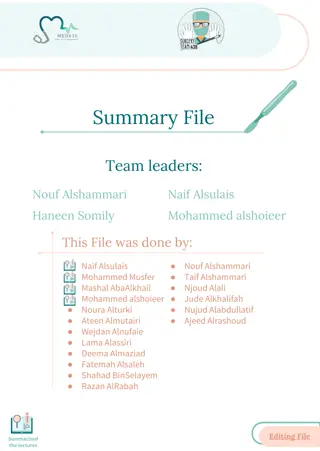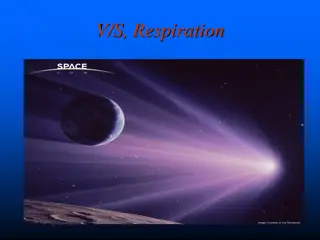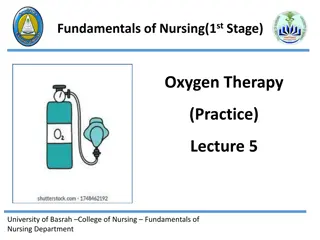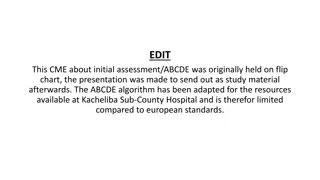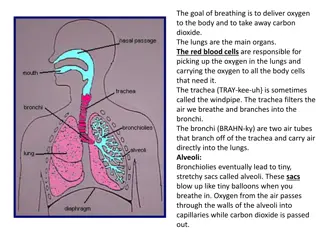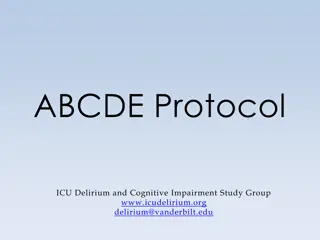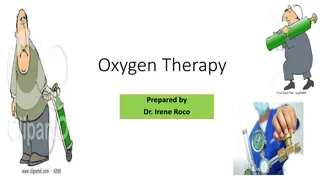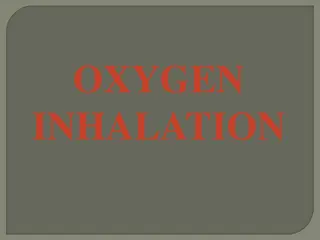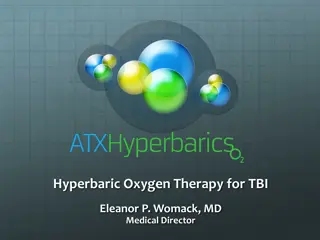Airway, Breathing, and Oxygen Therapy - ABCDE Approach Overview
ABCDE approach is a systematic method for evaluating acutely ill patients to identify and address life-threatening conditions promptly. This presentation focuses on the Airway and Breathing components, emphasizing the assessment, management, and interventions to maintain a clear airway and adequate breathing. It covers topics like airway anatomy, airway patency assessment, airway management techniques, and principles for managing unconscious patients. The aim is to equip healthcare providers with essential knowledge and skills to address airway and breathing issues effectively in emergency situations.
Download Presentation

Please find below an Image/Link to download the presentation.
The content on the website is provided AS IS for your information and personal use only. It may not be sold, licensed, or shared on other websites without obtaining consent from the author. Download presentation by click this link. If you encounter any issues during the download, it is possible that the publisher has removed the file from their server.
E N D
Presentation Transcript
Airway, Breathing and Oxygen Therapy Dr. Davidson Iroko 18/03/2022
Outline Airway assessment and management Breathing assessment and management Oxygen therapy
Introduction ABCDE approach provides a framework for the systematic and organized evaluation of acutely ill patients in order to rapidly identify and intervene for life-threatening conditions. The following slides will focus on the Airway and Breathing component of the ABCDE.
Airway Assessment MAIN CONCERN: IS THE AIRWAY PATENT? Can the patient talk normally? If YES, the airway is open. If the patient cannot talk normally: look to see if the chest wall is moving and listen to see if there is air movement from the mouth or nose. listen for abnormal sounds (such as stridor, grunting, or snoring) or a hoarse or raspy voice that indicates a partially obstructed airway. Stridor plus swelling and/or hives suggest a severe allergic reaction (anaphylaxis). Look and listen for fluid (such as blood, vomit) in the airway. Look for foreign body or abnormal swelling around the airway, and altered mental status. Check if the patient is able to swallow saliva or is drooling.
Airway management 1 AIM OF MANAGEMENT IS TO OPEN/KEEP AIRWAY OPENED. If the patient is unconscious and not breathing normally and: NO TRAUMA: open the airway using the head-tilt and chin- lift manoeuvre. CONCERN FOR TRAUMA: maintain cervical spine immobilization and open the airway using the jaw thrust manoeuvre.
Jaw Thrust Position yourself at the head of the patient place the hands at the sides of the patient s face Grasp the mandible at its angle, and lifts the mandible forward This lifts the jaw and opens the airway with minimal head movement Safest method for opening the airway if there is the possibility of cervical spine injury
Airway management 2 If secretions or vomit are present, suction when available, or wipe clean. Place an oropharyngeal or nasopharyngeal airway to maintain the airway. If a foreign body is suspected: If the object is visible, remove it be careful not to push the object any deeper. If the patient is able to cough or make noises, keep the patient calm and encourage coughing.
Airway Adjuncts Oropharyngeal airway Nasopharyngeal airway
Airway Management 3 If the patient is choking and is unable to cough, not making sounds use age-appropriate chest thrusts/ abdominal thrusts/back blows. If the patient becomes unconscious while choking, follow relevant CPR protocols. Consider placing the patient in the recovery position if the rest of the ABCDE is normal and no trauma is suspected. If the patient has swelling, hives or stridor, consider severe allergic reaction (anaphylaxis), and give intramuscular adrenaline.
Breathing Assessment Look, listen, and feel to see if the patient is breathing. Assess if breathing is very fast, very slow, or very shallow. Look for signs of increased work of breathing (such as accessory muscle use, chest indrawing/retractions, nasal flaring) or abnormal chest wall movement. Listen for abnormal breath sounds such as wheezing or crackles. With severe wheezing, there may be limited/no breath sounds on examination because narrowing of the airways may be so severe that breathing cannot be heard. Listen to see if breath sounds are equal on both sides. Check for the absence of breath sounds and dull sounds with percussion on one side (large pleural effusion or haemothorax). If there are no breath sounds on one side, and hypotension, check for distended neck veins or a shifted trachea (tension pneumothorax). Check oxygen saturation with a pulse oximeter when available
Breathing management 2 If breathing fast or hypoxic, give oxygen. If wheezing, consider giving nebulised salbutamol. Repeat salbutamol as needed and treat underlying cause. If concern for severe allergic reaction (anaphylaxis), give intramuscular adrenaline. If concern for heart failure, provide oxygen as required and get help/treat as appropriate.
3-sided occlusive dressing for open pneumothorax
Oxygen therapy This will be addressed in another presentation
Conclusion The ABCDE approach provides a framework for the systematic and organized evaluation of acutely ill patients in order to rapidly identify and intervene for life- threatening conditions. This presentation focused on the Airway and Breathing. The other aspects of the ABCDE approach are assessment & management of circulation, disability (neurology) and exposure and environmental control. In trauma, the life-threatening conditions one should identify include airway obstruction, tension pneumothorax, open pneumothorax, massive haemothorax, flail chest with underlying lung contusion, cardiac tamponade, and circulatory shock. After resuscitating with ABCDE approach and patient is stable, take SAMPLE history and perform secondary survey.
RISE Project Overview Reaching Impact, Saturation, and Epidemic Control (RISE) is a 5-year global project funded by the U.S. President s Emergency Plan for AIDS Relief (PEPFAR) and the U.S. Agency for International Development (USAID) which works with countries to achieve a shared vision of attaining and maintaining epidemic control, with stronger local partners capable of managing and achieving results through sustainable, self-reliant, and resilient health systems by 2024. Contact information: kelly.curran@Jhpiego.org At RISE: Kelly Curran, RISE Project Director (kelly.curran@Jhpiego.org) eberard@usaid.gov At USAID: Elizabeth Berard, USAID Agreement Officer s Representative (eberard@usaid.gov) This presentation was made possible through the United States Agency for International Development funded RISE program under the terms of the cooperative agreement 7200AA19CA00003. The contents are the responsibility of the RISE program and do not necessarily reflect the views of USAID or the United States Government.
